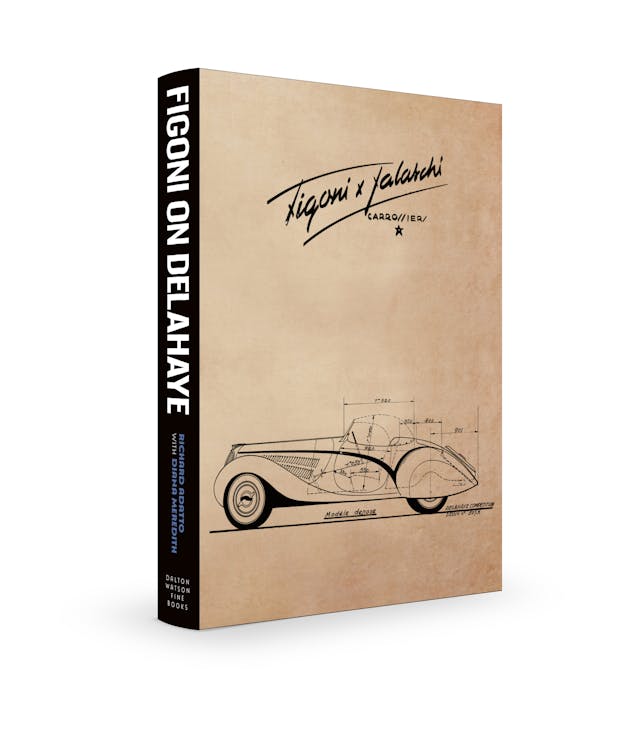Media | Articles
Figoni on Delahaye: Detailed insight into coachbuilt masterpieces
Figoni on Delahaye, the latest book by coachbuilt French car expert Richard Adatto, is a tribute to the creativity of designer Joseph Figoni. Published on the 100th anniversary of the Figoni coachworks, and co-written by Diana Meredith, this book examines 48 of the exceptional designs Figoni built on Delahaye chassis. Figoni’s work is recounted via a beautiful collection of period images, contemporary photos by Michael Furman, and Figoni’s sketches from Richard Adatto’s collection and the Figoni archive.
Like observing a musician’s capabilities through the lens of a specific album, or the work of an artist within a certain period, limiting the focus of this book to a single coachbuilder-car maker pairing is valuable in understanding a vital moment in the historical arc of the Figoni coachworks. While we’d have enjoyed the added context of seeing these masterful Delahaye-underpinned cars against Figoni’s other exceptional designs on chassis from marques like Alfa Romeo, Delage, and Talbot-Lago, Figoni on Delahaye does not suffer for it. Adatto’s personal recollections of his interactions with these cars—a perspective he’s uniquely capable of offering—alongside attractive and detailed visuals, highlight well Figoni’s avant-garde approach to the Delahayes he brought to life.
With help from Joseph’s son Claude, readers learn of Figoni’s humble upbringing in Italy, a move to France, and the subsequent founding of Carrosserie Automobile Joseph Figoni. The many period photos, documents, and advertisements establish the era when automobile speed records and concours d’elegance wins were marks of true automotive innovation.
The detailed, chassis-by-chassis account delves into what’s known about each car’s history. Where available, Figoni on Delahaye also shares how many of the type or style were built, the original paint scheme (which is helpful when looking at period b/w images), the distinctive design features of that particular coachwork, and its dimensions.

Any readers who might wonder what all the excitement is about only have to turn to chapters on chassis such as 48666, 49150, or 46576. These shining examples in particular show incredibly flowing Art Deco shapes formed out of sheet metal, chrome, and vents. The line between extravagant and the absurd can be a fine one, but Adatto and Meredith present well Figoni’s ability to create dramatic, beautiful, yet still fully functional design.
Marketplace
Buy and sell classics with confidence
Sadly, Figoni’s relationship with Delahaye couldn’t last. Both survived World War II, but the world had changed. Delahaye’s incrementally-updated independent front suspension and Figoni’s new Narval design theme didn’t prove viable enough transformations in the postwar car market, and the two ended their relationship.
The 1930s proved to offer a unique moment in time, where cars like Figoni-bodied Delahayes were primarily celebrated for their aesthetics. That might seem odd in 2023, as transportation moves closer towards autonomy and EVs. Figoni on Delahaye, now widely available for purchase, serves as a reminder of, and an appreciation for, the artistry of handbuilt cars and of man’s ability to create beautiful objects.

***
Check out the Hagerty Media homepage so you don’t miss a single story, or better yet, bookmark it. To get our best stories delivered right to your inbox, subscribe to our newsletters.










$250 on Amazon.
It’s good to just hear the word coachbuilt used again. While I’m no expert on this era of autos people forget that there was a time when manufacturers would produce a rolling chassis/engine and the body work was done by by a separate entity. So while they frequently had their preferred coachbuilders ( Cadillac -Body by Fisher- for example way back when ) and a book of available models, it was up to the purchaser to decide who would produce them. While now we may say- ‘ Duesenberg produced some of the most beautiful cars ‘- the design and sheet metal came from elsewhere. Even the VW Karmann Ghia is so named because the body was designed by Ghia.